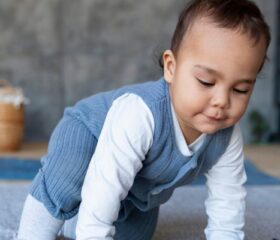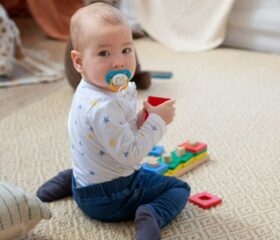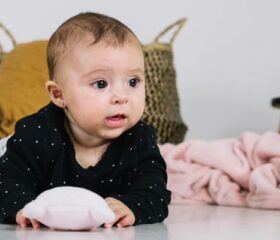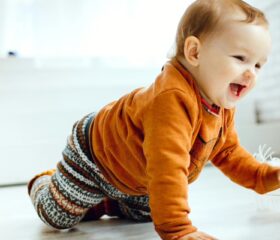When Do Babies Usually Start Babbling?
Few sounds are sweeter to a parent’s ears than their baby’s first attempts at talking—but when will you hear it?
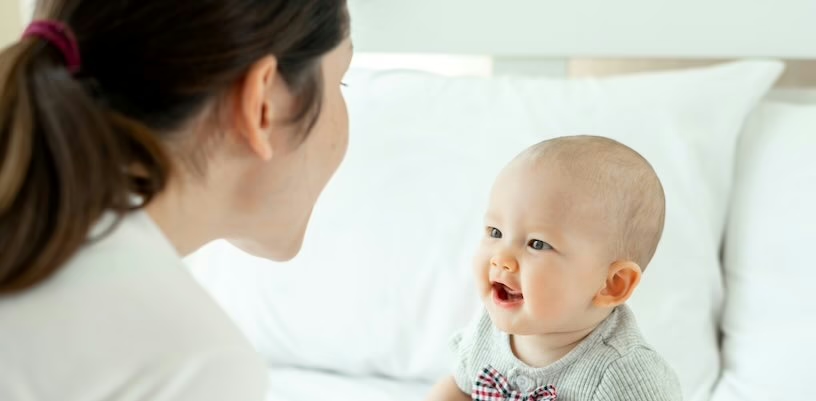
A few months after birth, your baby will start making noises that sound similar to (but not quite the same as) words. Those sounds are known as babbling.
Babbling is not only cute, it’s important for your baby’s speech development. Keep reading to learn when to expect those interesting sounds, what counts as babbling, how to encourage your baby to start babbling, and when you should be concerned if he isn’t.
What is babbling?
Babbling is an early language development stage in which babies produce consonant-vowel (CV) or vowel-consonant (VC) sounds, forming syllables like “ma,” “da,” or “gu.” After saying those syllables in isolation for a while, they’ll string them together and make sounds like “mamama” or “dadada.” 1
Despite sounding like nonsense, babbling helps babies develop their vocal muscles and explore different sounds and speech rhythms. They’ll gain the oral motor control needed to form actual words and sentences later on. 2
When will your baby start babbling?
Your baby may start babbling when he’s between 4 months old and 6 months old. This stage will usually last until at least his first birthday. 3 Babbling bridges the gap between cooing (making simple vowel sounds like “ooh” or “ahh”) and speaking. 4
Here’s a (rough) timeline of when you can expect your baby to hit different stages:
- Cooing: 2 months old to 4 months old
- Babbling: 4 months old to 12 months old
- First words: 12 months old to 18 months old
While 4 to 6 months is the common range, don’t fret if your baby starts babbling a little later. In fact, the Centers for Disease Control and Prevention (CDC) lists babbling as a 9-month-old language development milestone, meaning it estimates just about 75% of babies are babbling at that age. 5
How does babbling develop into speech?
Your baby’s babbling will evolve as he gains more control over his mouth, tongue, and breathing. Here are the three main babbling stages: 2
- Early babbling: When your baby is around 4–7 months, he may utter single syllables such as “bu,” “ma,” or “da” and string them together into “mamama” or “bababa.”
- Canonical babbling: At around 7 months old to 12 months old, he may mimic your speech patterns and make more complex sounds with different intonation and stress patterns, such as “baba-gaga-mama.”
- Variegated babbling: From 12 months onwards until he starts speaking for real, his babbling will become even more complicated. You may hear him babble sounds like “mabaga” or “batamada.” It might even sound like he’s having a conversation with you.
Your baby will gradually become more aware of what will become his native language and will try to utter simple words as his babbling progresses. 2
You can keep track of his progress in your journal or in a baby tracker app. The best baby trackers also provide general timelines for when you can expect your baby to hit these milestones.
Does your baby’s babbling mean anything?
In the first few months, your baby’s babbling doesn’t mean anything specific. He’s still communicating, but it’s experimental; he isn’t trying to say real words. 1
At about 10 months old, as he starts to imitate the sounds he hears, you might pick out sounds that strongly resemble words, like “mama” or “dada.” While your baby might not understand the full meaning yet, he’s getting closer to linking sounds with concepts. 1
As he masters babbling, he may also begin to use gestures, such as pointing, to express his needs and emotions. 1 3 This shows he understands more than he can articulate.
Why is babbling important?
Babbling is much more than just nonsensical (if adorable!) noise. It’s a crucial part of your baby’s language development that lays the foundation for speech. 1
We’ve briefly touched on what babbling achieves earlier; here’s a more comprehensive and detailed look: 2 6
- Oral motor skill development: When your baby babbles, he’s giving his mouth, tongue, and jaw a workout. He’s learning to coordinate those muscles and experimenting with breath control. Doing so prepares him for forming recognizable words down the line.
- Sound exploration: Your baby uses babbling to explore sounds his voice can create. He’s testing out different pitches, volumes, and sound combinations.
- Imitation practice: Babbling also allows your baby to imitate the sounds and words he hears from the people around him. It’s like a rehearsal for actual verbal communication.
- Social connection: Your responses to your baby’s vocalizations teach him that talking is a social exchange. This encourages him to keep trying to “talk” to other people, which he’ll get better and better at as he gets bigger. Note that toddlerhood is when babies usually start talking for real.
How do you encourage babbling?
Your baby will babble when he’s ready. However, you can help him reach that stage with simple yet effective methods:
Talk to your baby often
The best way to help your baby’s speech development is to talk to him. 6 Your baby needs to hear adults talk to each other or directly to him in the first few weeks of his life to learn how to babble. 1
If you don’t know what to say, just narrate your life. For example, when you change his diaper, say, “I’m about to lift your legs up now” or “Now we’re putting on a clean diaper.” You can also sing and read to him. 6
You may want to introduce the words “yes” and “no.” While your baby may not understand what no means straight away (much to your dismay), there’s no harm in setting those boundaries early on.
When your baby babbles to you, talk back to show you’re listening. 6 Pause for a second to let him process your sounds and respond to you. See how long you can keep up this “conversation” with him.
Use “parentese” when talking to your baby
Also known as “motherese,” parentese is when you use a slower, higher-pitched voice with a singsong rhythm to talk to your baby. Your baby may respond better to the slower tempo and exaggerated sounds. 6 7
Note that babies often read people’s facial expressions and gestures to understand the words they’re saying. 7 Try talking to your baby face-to-face, so that he can see and copy you.
If your household is bilingual, feel free to talk in both languages
Some parents in bilingual households are concerned that talking in both languages may confuse their babies or cause them to experience speech delay. Fortunately, that isn’t the case. To the contrary, encourage your baby to talk in multiple languages!
Name items for your baby
You can help your baby connect words with items by naming the things he’s looking at, pointing to, or babbling at (sometimes simultaneously). 8
For example, if he makes a sound like “ba” while looking at his bottle, you could say, “Oh, you want your bottle!” This helps him link his sounds to meaningful words. Repeat your words to plant them in his brain. 6
Encourage self-talk in your baby
As the saying goes, practice makes perfect. The more your baby babbles, the quicker he’ll master it and move on to true speaking.
If you find your baby babbling to himself when he wakes up or plays alone, try not to interrupt him. Let him go on as long as possible.
Do activities that let your baby practice babbling
Playtime is a great time to practice babbling with your baby. In addition to singing lullabies and reading books, try these activities to build his language skills:
- Mirror play: Hold a mirror in front of you and your baby in a way that lets you both see your mouths. Make sounds like “ma-ma-ma” and “ba-ba-ba” and point to your mouth as you speak. This encourages him to mimic you.
- Toy-naming: Gather a few toys with names that begin with a specific letter, such as “b” (e.g., ball, block, book). Take them out one by one and name them while emphasizing the “b” sound. Repeat your words to help your baby learn.
- Texture card-reading: This educational tool stimulates your baby’s senses and language development. Use cards with realistic images and name the objects clearly. Again, repeat your words and give your baby time to mimic your sounds.
While you’re building these activities into your baby’s routine, make sure you’re also avoiding TV and screen time, which doctors and other experts discourage in young children.
When should you see a doctor about your baby’s babbling?
It’s natural to feel anxious if your child seems to be on a different timeline than his peers. Try not to fret; as you’ve likely heard a million times, children develop at their own paces.
That said, according to the Centers for Disease Control (CDC), it’s a good idea to talk to your doctor if your baby still isn’t babbling by 9 months. 5 They can assess if your baby just isn’t a big talker or needs intervention. Causes of not babbling by this stage can include speech delay, hearing loss, or developmental disorders, such as autism.
If you have a gut feeling that something’s wrong despite your doctor suggesting a “wait-and-see” approach, consider scheduling an evaluation with a speech-language pathologist (SLP). After all, it never hurts to get a second opinion.
Final thoughts
Babbling is an exciting milestone for your little one. He’s getting better and better at expressing himself and is just a few months shy of saying actual words! Keep encouraging him to talk to help him unlock new language skills.
Article Sources
- Before their first words (RecerCaixa). "Early babbling" Retrieved August 25, 2025.
- Imperial Valley College. "Define Babbling: Understanding Infant Language Development and Beyond" Retrieved August 25, 2025.
- South Dakota Department of Education. "Language Milestones" Retrieved August 25, 2025.
- Yale School of Medicine. "Understanding language development milestones" Retrieved August 25, 2025.
- Centers for Disease Control and Prevention. "Important Milestones: Your Baby By Nine Months" Retrieved August 25, 2025.
- Help Me Grow. "Babbling and a Baby's Language Development" Retrieved August 25, 2025.
- Pima County Public Library. "How you talk with your child matters" Retrieved August 25, 2025.
- Centers for Disease Control and Prevention. "Important Milestones: Your Baby By Six Months" Retrieved August 25, 2025.


